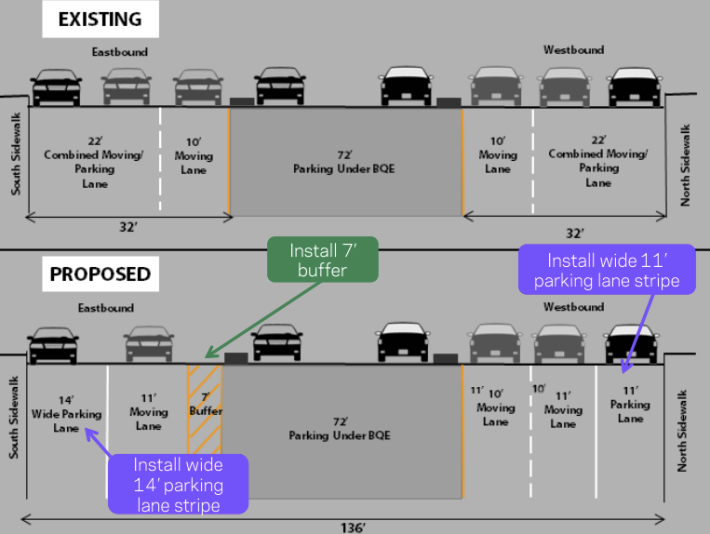
Last night, Brooklyn Community Board 2's transportation committee unanimously supported a set of traffic calming measures on Park Avenue in Clinton Hill and Fort Greene, including a road diet for eastbound traffic [PDF]. The proposal from DOT comes after years of advocacy from local residents and organizations fed up with speeding and dangerous conditions on the roadway beneath the Brooklyn Queens Expressway viaduct.
The one-mile stretch of Park Avenue between Navy Street and Flushing Avenue ranks in the worst third of Brooklyn streets for traffic crashes, with nearly three in four drivers speeding, according to DOT, which clocked drivers going as fast as 52 mph.
A third of crashes on Park are right-angle collisions, usually involving a driver running a red light. These types of crashes are so common that a supermarket at the corner of Park and Washington Avenues captured two of them on camera within 20 days last winter, including one where a driver plowed through the store's front door and into the produce section.
DOT's plan builds on the recent addition of street lights and the removal of parking to improve visibility at corners. It incorporates many of the suggestions from the Park Avenue Pedestrian Safety Plan, produced in 2012 by the Myrtle Avenue Revitalization Project Local Development Corporation (MARP) with assistance from Architecture for Humanity New York -- the culmination of years of community workshops and organizing. A petition in support of MARP's plan gathered more than 1,100 signatures.
The biggest change under DOT's plan is a reduction in the number of eastbound lanes from two to one, with a 14-foot parking lane and a 7-foot striped buffer along the median. At the intersections of North Portland, Clermont, and Vanderbilt Avenues, eastbound Park Avenue will include a right-turn lane to accommodate higher volumes of car traffic.
Westbound Park Avenue carries approximately double the traffic of the eastbound lanes during evening rush hour, and it will retain two lanes under DOT's plan, which restripes them to more clearly mark the parking lane.
DOT proposes a few more changes. Traffic signals will be retimed to reduce speeding, and pedestrians will gain two seconds of crossing time during peak hours and six seconds during evening hours. This will make it easier to cross the 136-foot-wide avenue, with its twin 32-foot roadways and 72-foot median.
Currently, the median underneath the BQE is used for parking, which drivers access using curb cuts on north-south streets beneath the expressway. These short sections of cross streets are often filled with drivers who have turned off Park but are waiting for a green signal before crossing opposing traffic. Pedestrians who have crossed half of Park Avenue also wait under the BQE for walk signals. DOT's plan would reduce conflicts in these crowded locations by closing some of the entrances to parking areas with plastic bollards and adding stop signs to the remaining entrances.
The plan does not make many changes to the complicated crossover intersection of Park Avenue and Williamsburg Place, where surface traffic zig-zags under the BQE as the highway curves northward near Flushing Avenue. It's a particularly dangerous location: Cyclist Stefanos Tsigrimanis was killed here in 2010. MARP's plan envisioned a major realignment of streets here to create a new public plaza space, but acknowledged that it was a longer-term recommendation. In a press release, MARP says it is asking DOT for capital improvements to Park Avenue, including fixes to the crossover intersection.
For now, DOT is proposing only a slight tweak by changing southbound Williamsburg Place from two lanes to one. This eliminates what DOT calls an "awkward" merge from three lanes as Wiliamsburg Place meets Park Avenue between Grand Avenue and Ryerson Street.
The plan now goes to CB 2's full board meeting on June 11. DOT says it could be implemented as soon as September.
This post has been slightly modified to reflect the roles of MARP and Architecture for Humanity in developing the Park Avenue Pedestrian Safety Plan.





